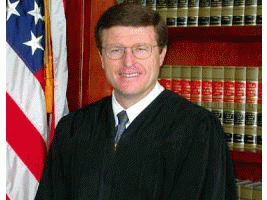sua sponte: (sooh-uh spahn-tay) adj. Latin for "of one's own will," meaning on one's own volition, usually referring to a judge's order made without a request by any party to the case. [law.com]
On January 11, 2016, in Jones v. Davis, [1] Jones filed a Petition For Rehearing And Petition For Rehearing En Banc in the Ninth Circuit. This article argues that the petition should be granted, but decided on grounds beyond those set forth in the petition, and that the case is an ideal vehicle for reconsidering the constitutionality of the death penalty la Justice Breyer's June 2015 dissent in Glossip v. Gross, [2] where, joined by Justice Ginsburg, he wrote:
[R]ather than try to patch up the death penalty's legal wounds one at a time, I would ask for full briefing on a more basic question: whether the death penalty violates the Constitution [which] forbids the "inflict[ion]" of "cruel and unusual punishments."
In 1995, Ernest Jones was sent to California's death row for a horrific rape-murder. [3] After seemingly exhausting state remedies, Jones sought a writ of habeas corpus in the Central District of California, under the Anti-terrorism and Effective Death Penalty Act of 1996 (AEDPA), 28 U.S.C. 2254 . As follows, Judge Cormac Carney (a George W. Bush appointee) startled the legal world by preempting Jones' original petition, which has yet to be heard.
Since 1978, California has sent over 900 convicts to death row, but the death sentences of only 31 have become final (of whom 13 have been executed), while 87 have died of natural causes or suicide. Finding this due to systemic backlogs in hopelessly underfunded state postconviction review processes, on July 16, 2014 Carney issued a 29-page Order Declaring California's Death Penalty System Unconstitutional , [4] as arbitrarily selective, under the landmark case of Furman v. Georgia , [5] which in 1972 conditionally nixed the death penalty nationwide. Carney's Order states (at 2; emphasis in orig.):
[T]he dysfunctional administration of California's death penalty system has resulted, and will continue to result, in an inordinate and unpredictable period of delay preceding [] actual execution. Indeed, for most, systemic delay has made their execution so unlikely that the death sentence carefully and deliberately imposed by the jury has been quietly transformed into one no rational jury or legislature could ever impose: life in prison, with the remote possibility of death. As for the random few for whom execution does become a reality, they will have languished for so long on Death Row that their execution will serve no retributive or deterrent purpose and will be arbitrary.
Unfortunately, in Jones v. Davis, a Ninth Circuit panel vacated Carney's Order on what the media universally reported as purely procedural/technical grounds, quoting the holding that "[b]ecause Petitioner asks us to apply a novel constitutional rule, we may not assess the substantive validity of his claim." [6] In so ruling, the panel turned a blind eye not only to its own sua sponte powers, but to the already exercised sua sponte power of the district court, in finding the claim substantively valid.
Despite not ruling on the claim's "substantive validity," the panel's ruling was formally on the merits, and it entailed " a detailed analysis of federal constitutional law." [7] The petition for rehearing (at 13-16) even complains that the merits should not have been reached. In fact, so as to find that the claim was novel (and therefore avoidable), the panel decisively and dispositively suppressed both Furman's holding that death penalty regimes resulting in freakishly rare executions are arbitrary per se, [8] and Furman's requirement that discretionary death sentencing be formally fettered , including through adequate appeal processes. [9]
To rescue the record from inherently irrelevant confusions, and to correct the drastic suppression of Furman, an en banc Ninth Circuit panel should sua sponte articulate and apply a proper standard for reviewing sua sponte trial court decisions. Under that standard, it should reach the merits of Carney's Order, and vigorously restore it.
************************
The home page of California's state-funded Habeas Corpus Resource Center, which acts as Jones' counsel, has long been given over to Jones v. Davis. It provides links to all substantive Ninth Circuit filings, including nine pro and one con amicus briefs. [10] Interest in the case caused the Ninth Circuit to create a similar Jones page .
Despite the wide public interest and the life-and-death import of the issues, most of the parties' argument and of the court of appeal opinion is small-minded, irrelevant, confused, and/or worse. In the petition for rehearing (at 15-16) Jones himself presents arguments against Carney's basic finding of futility in returning the case to the California courts, to first exhaust state remedies. In all prior filings, Jones passionately, convincingly, and of course argued in support of the futility finding. This tactical repositioning [11] perversely condemns Carney's Order not only under the essentially irrelevant exhaustion of remedies provision of AEDPA, but also under the pertinent "enough is enough" or "justice requires it" sua sponte discretionary standard.
What's up? It's a long story, fully told in a paper that this article is in part written to recommend, namely, Judge Carney v. The Death Penalty: Ninth Circuit Panel Suppresses Furman's Repudiations Of Dysfunctional Sentencing And Freakishly Rare Execution Regimes . The paper thoroughly addresses the common law context and the record in Jones at face value (i.e. under AEDPA), before presenting the sua sponte perspective of this article as a take-it-or-leave-it final point.
************************
The sorry record in Jones is not primarily the fault of the parties or of the court. After Carney ordered Jones to file a claim of the court's creation, everyone, including Carney, by default fell into the habit of applying AEDPA pleading standards. This is understandable, given the lack of any articulated standards for the sua sponte creation of issues, and for reviewing the sua sponte creation of issues. As Bradley Scott Shannon explains:
Quietly, [] sua sponte decisionmaking has become de rigueur, but there is no articulated set of criteria for determining when such power should [] be exercised . . . [S]ua sponte decisionmaking [lies on] a spectrum . . . At the most permissible end of the spectrum, one might place decisions that seem to be mandatory, such as dismissals for lack of subject-matter jurisdiction [12]
Carney's Order, by affirming a legal theory of his own creation, albeit within the compass of the extant controversy (seeking the same relief, based on essentially the same facts), lies at the least permissible end of the spectrum, and must be extraordinarily justified. On the other hand, the sua sponte discretion required for an en banc Ninth Circuit panel to announce and apply the appropriate sua sponte standards to Carney's Order, lies at the most permissible, maybe-mandatory end of the spectrum. The standards to be applied are matters of district court jurisdiction, [13] and so also of appellate jurisdiction, which the court of appeal has a routine duty to independently determine. A regular cause for raising issues sua sponte is "[t]he judiciary's interest in protecting the constitutionally demarcated limits on its authority." [14]
(Note: You can view every article as one long page if you sign up as an Advocate Member, or higher).






